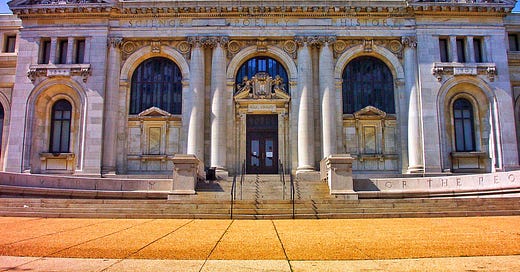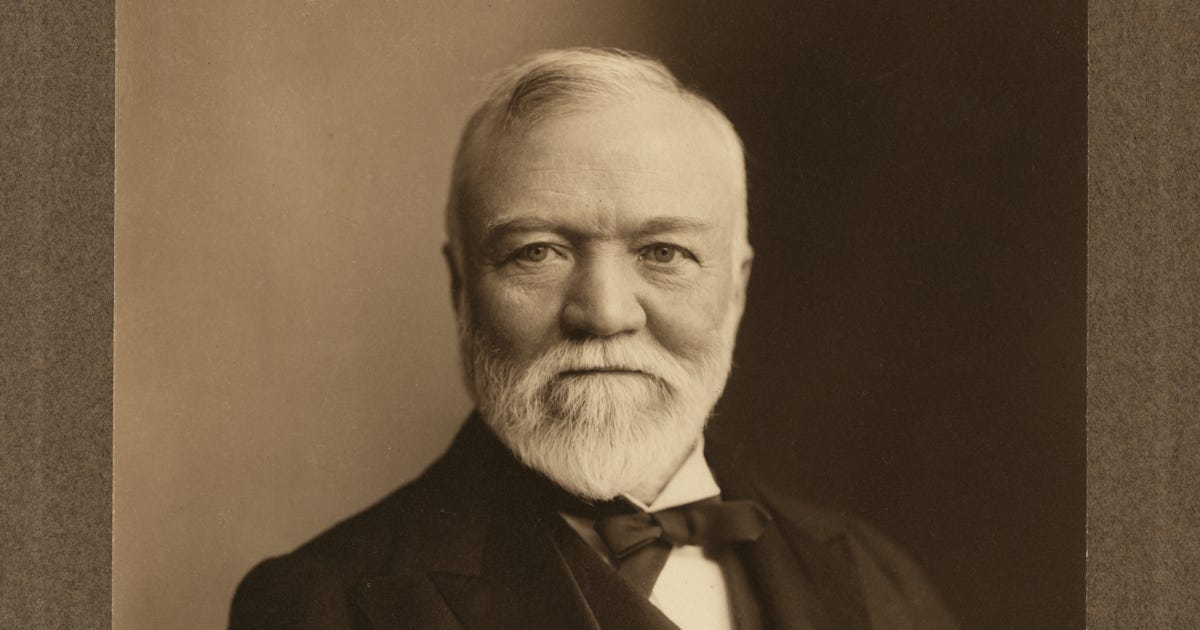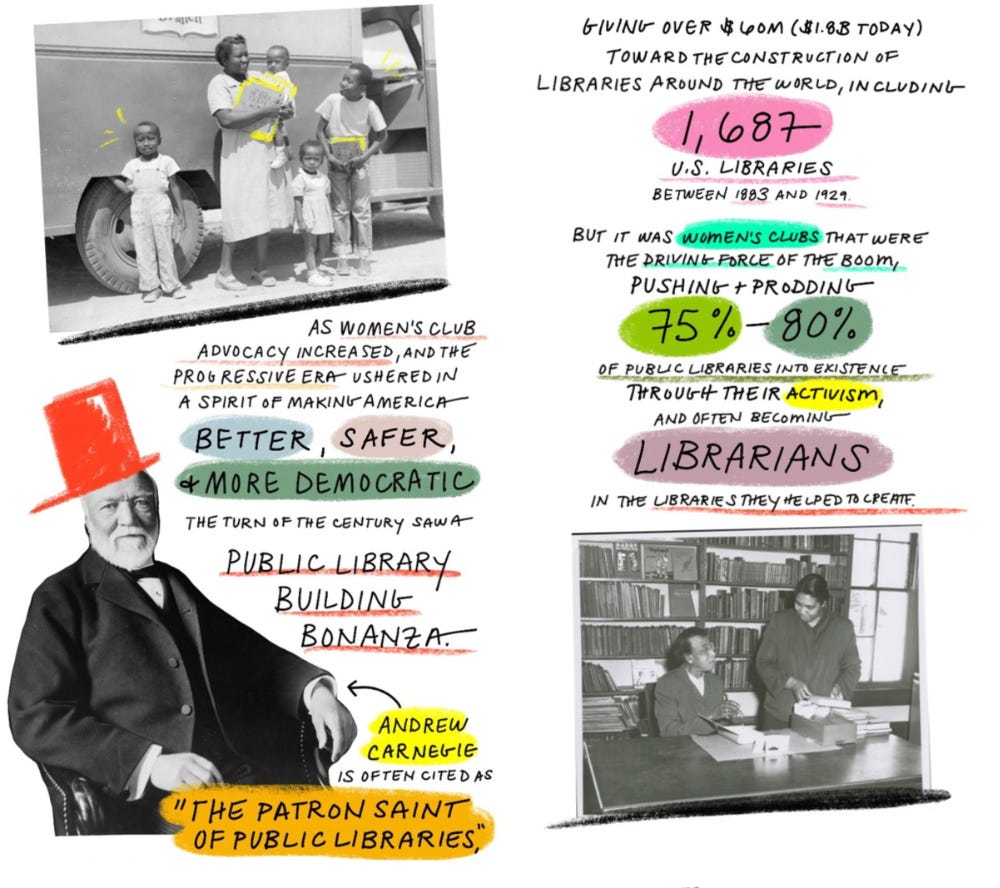📗 Overdue, Part 2: Carnegie’s plan for scale
How to build a sustainable, nationwide social infrastructure
This week we resume our series on library-building in America. Last week we traced the expansion of libraries from Ben Franklin through the turn of the 20th Century and now we’ll take on Andrew Carnegie’s massive “disruption of the library space.” We’ll assess how he pulled it off, examine the impact of this legacy, analyze the contemporary state of American libraries, and contemplate the future. (phew!)
Why did Carnegie put such a large piece of his fortune1 into public libraries? Who benefited and who was excluded from his largess? How did Carnegie spend so much, so effectively, and have most of the investment still in use a century later? What lessons does his funding offer for those interested in the building of large-scale social infrastructure?
We’ll also consider today’s billionaire philanthropic class and their responsibilities and opportunities towards making a contribution on the same order as Carnegie.
🕦🕚🕥🕙🕤🕘🕣🕗🕢🕖🕡🕕🕠🕔🕟🕓🕞🕒🕝🕑🕜🕐🕧🕛🕦🕚🕥🕙
Mr. Steel and Trains
As a reminder:
Until the mid 19th century, many US libraries were private, pay-to-join, and exclusionary towards women and people of color.
The library movement helped expand free, public libraries throughout the country.
Coming into the 20th century, many libraries were still dependent on private wealth and were far more common downtown than in residential communities.
Enter: Andrew Carnegie. Despite experiencing childhood poverty, Carnegie would go on to build a fortune in steel and railroads so immense that, at least at one point, he was the richest man in the world. And then, incredibly, he chose to give away 90% of his wealth towards the public interest, according to The Library, an Illustrated History by Stuart A. P. Murray.
However, as Eric Kleinenberg put it in his book Palaces for the People, “He was a true ‘robber baron,’ who allowed managers to hire hundreds of armed Pinkerton detectives and violently suppress unionized workers during the Homestead strike, and lobbied fiercely against the income tax and other government efforts to address inequality.”
Why libraries?
So why did this robber baron get into the large-scale library funding business? Carnegie’s critics accused him of building libraries to burnish his ego, but it was probably more complicated. In the biography Andrew Carnegie, David Nasaw notes that it was not a requirement that the buildings have the name “Carnegie” on them, and if a city wanted a bust or portrait of Carnegie, they had to pay for it.
Carnegie seemed to genuinely believe in his “gospel of wealth” — that the natural order of society was for some individuals to accumulate tremendous wealth and then give it all away. He hated the idea of giving charity directly to the poor, and preferred funding public institutions where people could better themselves. Carnegie experimented with funding museums, universities, music halls, and other institutions, but with libraries, he found his niche.
With libraries, he sought to not only build physical structures, but to shift the norms and expectations around library funding in the US. With Carnegie, not only were “strings attached,” they were the actual point of the grant. According to Nasaw, Carnegie described each monetary gift as a “bribe” to sway municipalities into funding libraries as they did hospitals and schools. “His real purpose was not to found libraries, himself, but to force the communities to do so,” writes Nasaw. Knowing that the cost of constructing each edifice would eventually pale in comparison to the costs of yearly re-investments in staff, books, and maintenance, Carnegie made those things compulsory.
How to spend $60 million dollars in the early 1900s
From the start of his library funding, Carnegie made every city or town agree to this narrow set of conditions. To receive a cash infusion that would pay to build a new library, a community …
must maintain the library as public property and pay staff
must spend 10% of the original gift each year
cannot use private donations to fund the library going forward
Applications for libraries started pouring in. However, as the operation gained momentum, Carnegie actually spent less and less time focusing on it. Carnegie’s hypercompetent trustee, James Bertram, systemized the library gifts into a streamlined process. Everything was on rails: if an application met the requirements, which Nasaw writes were “based on hard data about population, taxation, and site availability,” it was funded. The pace of the giving increased, from 132 grants in 1901, to the dispersal of 10-20 grants every day in 1908.2
Carnegie’s giving offers two other key lessons about philanthropic funding of social infrastructure. His libraries were intentionally built with flexibility, so they could adapt over time. For example, lecture halls were standard, but the communities could determine how they wanted to use them. Still, the library designs were not completely conservative and utilitarian — Carnegie libraries incorporated new, contemporary features such as open-stack browsing and spaces specifically for children. It’s also worth appreciating that library-construction money went really far in the early 20th century. For a variety of reasons, including poor labor standards, construction of buildings, even in relatively dense, urban areas, was far less costly and complicated than it is now.
Some benefit, others are left out
Carnegie funded some truly epic central library branches, but also dramatically expanded the reach of library systems into residential areas. But it’s really important to note that he didn’t do this single handedly. Carnegie made the offer to build libraries, but behind the scenes, as Ariel Aberg-Riger shows in this fantastic visual essay, women’s clubs often built support for libraries and raised money to sustain them.
Not only did women help get all these new libraries built, but they showed up to work in large numbers. “At the time,” writes Susan Orlean in The Library Book, “one of the few job paths open to women was teaching, and librarianship was a natural lateral move. Because the need for librarians was so great, the usual male resistance to opening ranks was overridden by the urgency for more staff.”
But Carnegie’s building boom excluded some Americans. These new libraries were being constructed in an unequal, segregated society. In some communities, Black patrons were required to use the back door, or only attended on certain “black-only days.” In twelve communities, “colored Carnegie libraries” were built, which Aberg-Riger writes were highly popular but poorly-resourced. Later on, segregated libraries became focal points for sit-ins and other civil rights activism.
Libraries now
Now, in the 21st century, library use has increased nearly everywhere, even with the rise of the internet. Libraries now have a much larger mandate to serve the community beyond books. This has been underlined by the pandemic. Examples from this year’s “State of America's Libraries Report” from the American Library Association offer a glimpse of the range of services that have moved online in a hurry: virtual storytime, cooking demos, sign language classes, book clubs — all conducted over Zoom. Some libraries found success in curbside pickup for books, multimedia, and even devices to help bridge the digital divide. Especially in the last two years, library staff around the country have shown incredible creativity and fortitude while serving their communities. And yet, it’s clear that in many places, they are being asked to do more with less.
Ultimately, Carnegie’s dream was realized — there are a lot more free, public libraries, and about 80% of public funding comes from local communities. However, as has been the case throughout American history, the poorest communities have the fewest resources. Even as Congress has increased federal library funding eight years in a row, it’s still a very small part of overall funding.3 Kleinenberg writes in Palaces:
Today, libraries in most places are starved for resources. Across the country, branch libraries have reduced their hours and days of operation despite rising attendance and circulation, leaving those with weekday obligations like work and school with fewer opportunities to visit. They’ve downsized staff, cutting back on librarians as well as on basic services like sanitation and information technology. They’ve decreased the budget for new books, periodicals, and films.
Carnegie 2.0?
Assessing the needs and opportunities in funding libraries in 2022, you might wonder why none of our contemporary billionaires are stepping in to attempt something like Carnegie did. Kleinenberg certainly does. “How much more wealth do they need to accumulate before they are ready to help?” he asks, noting that Silicon Valley’s entire industry depends on “a technology developed by the government—the Internet—and a publicly funded communications infrastructure.” It’s a good question, without an easy answer.
I don’t mean to imply that billionaires aren’t donating to libraries today. For example, Jeff Bezos (worth an estimated $177 billion) is giving $2.7 million to my library system, the District of Columbia Public Library. Some are outraged that our central library’s auditorium will be renamed after him, but I’m outraged that his gift is the largest the system’s foundation has ever received. A century ago, DC’s Carnegie Library (photo above) cost $10 million in today’s dollars. (It’s now an Apple Store 😭)
It seems to me that a massive, Carnegie-style investment in the future of libraries is just sitting there for a billionaire to slam dunk. If Bezos wanted to invest in libraries on a scale comparable to Carnegie, it would cost more than 30 billion dollars. Luckily, Carnegie gives us a great template on how to do it. If Bezos or any of the 1% feel moved by the gospel of wealth and seek to unburden themselves of what Carnegie called “surplus wealth,” they should:
Put some truly massive grants on the table
Leverage the activism of those passionate about the future
Come up with conditions that guarantee sustainability over time
Fund something adaptable, that can be a framework for future needs
Fund something that scales as cheaply as construction in 1901
Find a niche with huge demand and need (take your pick!)
Build a simple process run by capable administrators
Surpass Carnegie by prioritizing equity
The library of the future
You might be saying to yourself: but aren’t all the libraries already built? What’s the next frontier? This brings us to our final can of worms in this series: What would a public library look like on the internet? This question is so intriguing, yet so complex and nuanced, that many of you had a lot to say on the subject last week in our most engaged Open Thread in months. Some of you thought that anything attempting to replace libraries digitally was inexorably doomed to fail, and others were eager to bring their favorite features of their library — from shushing librarians to storytime — to some corner of their daily digital routine.
We believe this conversation is just getting started. We did a Library Design Sprint with librarians, designers, and researchers in summer 2020, and we tracked how Brooklyn Public Library went online early in the pandemic in our Terra Incognita project. This is a topic we’re still extremely interested in, and I’m looking forward to revisiting it in future newsletters. If you have a vision for the intersection of technology and libraries, we’d love to hear more about it in the comments, even if you’re not a billionaire.
Newsletter shoutout
One non-library plug to send you off:
Consider checking out Charley Johnson’s newsletter, Untangled, a monthly email full of research relevant to our interests in digital public spaces. Charley leads a new initiative at Data & Society and has a great perspective on “technology, people, and power.” He has a recent interview with Daphne Keller — who we talked to about circuit breakers — and a deep dive on decentralization, the topic of our first magazine issue.
Finally returning these library books,
Josh
Design and illustration by Josh Kramer. Photo of Carnegie from the Smithsonian. Photo of the Carnegie Library by Creative Commons user Onasill ~ Bill. Excerpt of “A History of the American Public Library” by Ariel Aberg-Riger from CityLab.
New_ Public is a partnership between the Center for Media Engagement at the University of Texas, Austin, and the National Conference on Citizenship, and was incubated by New America.
The figures about how much Carnegie spent on libraries can get confusing. The consensus seems to be that Carnegie spent about $60 million on libraries total, with $40 million of that going to US libraries. Biographer David Nasaw puts that in context: “In his lifetime, he gave away more than $333 million—90 percent of his fortune.”
These figures also include the funding of church organs, another project of Carnegie’s.
State and federal funding comprise less than 10% of library funding, with the rest coming from sources like philanthropy.








Such a fascinating (hi)story of the intricate links between public libraries and their communities! You may be interested in projects we have been doing in the Netherlands and Czech Republic on exploring how public libraries can strengthen social innovation in, with, and by the local communities they nourish: https://www.communitysense.nl/2019/03/19/mapping-the-social-innovation-ecosystems-around-public-libraries-together-the-czech-connections/
We need an easily accessible public forum where we can dialogue with others on issues of mutual interest.